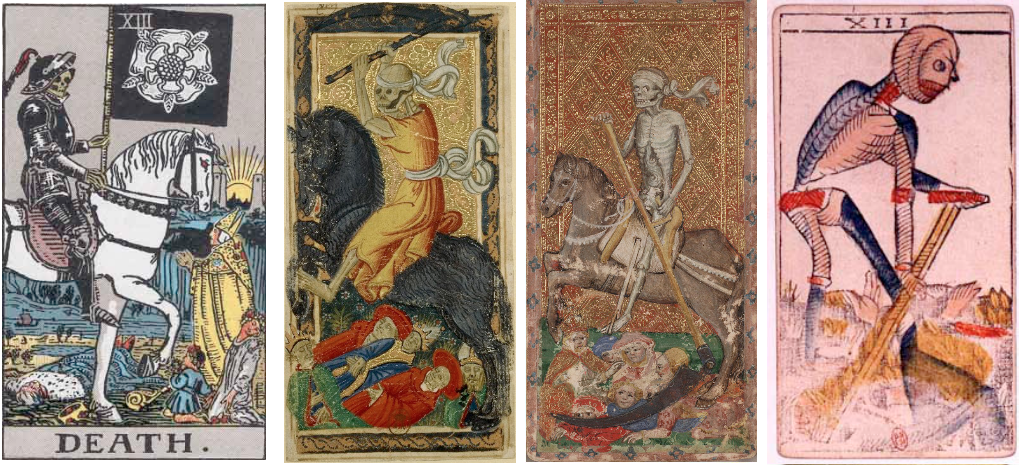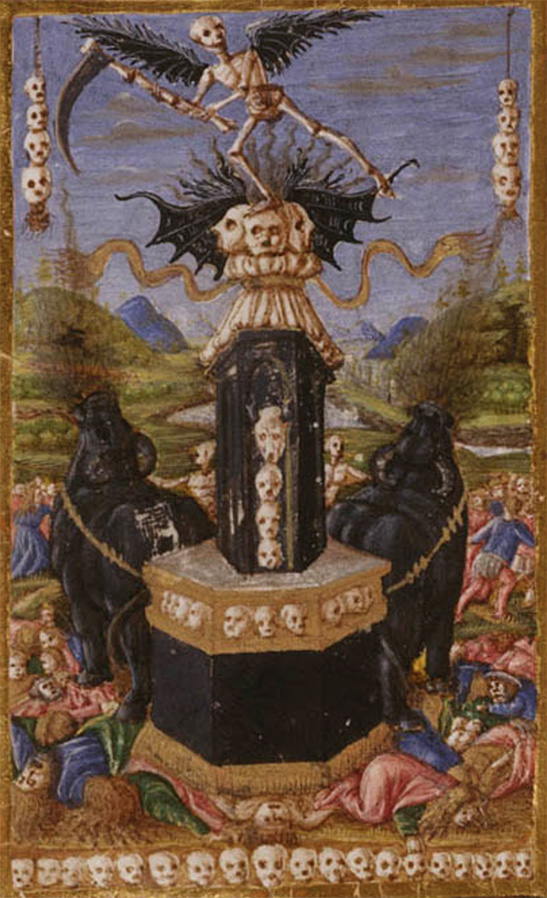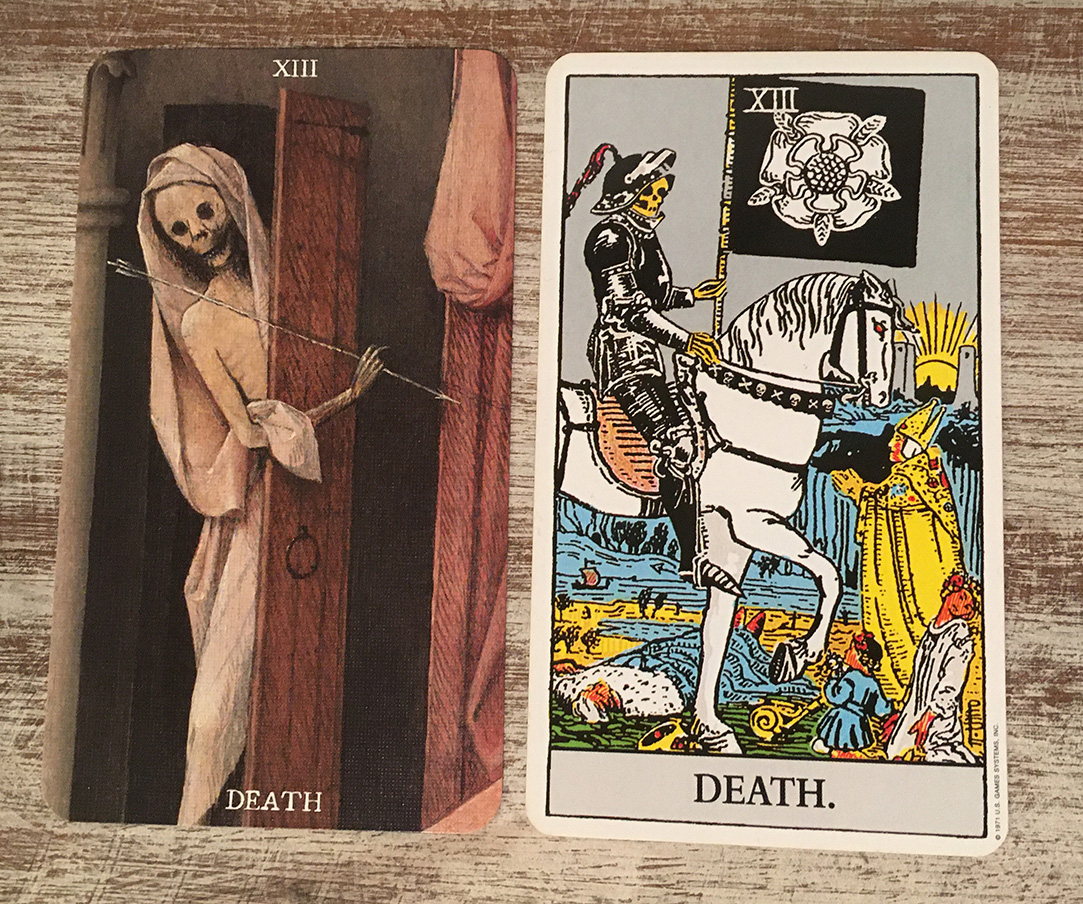Death
Death is the 13th card in the Major Arcana in most traditional Tarot decks.
It is associated with the qlippoth of Satariel ("Concealers") on the Kabbalistic Tree of Death.
History
In the 1374 trionfi poem which inspired the creation of the tarot, Death was the name of one of the six original triumphs.
The painting of Death depicts a carriage carrying a massive black monument of death with a skeletal angel of death on top. Two black bulls are pulling the carriage backward and the entire surrounding crowd of onlookers are all dead or running away from the approaching bulls. Additional skulls adorn the edges of the painting.
Rider-Waite Depiction
A mysterious horseman moves slowly, bearing a black banner emblazoned with the Mystic Rose, which signifies life. Between two pillars on the verge of the horizon there shines the sun of immortality. The horseman carries no visible weapon, but king and child and maiden fall before him, while a prelate with clasped hands awaits his end.
Depictions in other decks
Some decks, such as the Tarot of Marseilles and Visconti-Sforza Tarot omit the name from the card, calling it "The Card with No Name", often with the implication of a broader meaning than literal death. There are other decks that title Death as "Rebirth" or "Death-Rebirth."
The Vlad Dracula Tarot depicts the aftermath of the death of Vlad the Impaler at the hands of the Ottoman soldiers, showing his severed head on display outside a Turkish castle while the Ottoman battle flag flies high behind it.
The Hieronymus Bosch Tarot retains the classic image of death as a pale skeleton, using Bosch's painting "Death and the Miser" as its source.
Symbolism
The picture on the card speaks for itself, but still there is more in it than we might suppose at first sight. Beyond all doubt it is a sort of allegorical representation of Father Chronos, who, while creating, consumes his own children, and was very often pictured as a warning of death or a remembrance of mortality. But on the other hand Time marks the beginning, and birth is not less under his government than death. The earlier editions of this card show the figure harvesting heads and limbs of human bodies upon a field. This may be an expression of an old superstition, which said that those limbs with which man sinned would grow out of his grave.
Creation necessitates equal destruction in a contrary sense, and therefore all the regenerations that have sprung from previous destruction, all transformations, and consequently death, are regarded as the passage from one world to the other. The ideas expressed by this arcanum are those of destruction preceding or following regeneration. The thirteenth card of the Tarot is placed between the invisible and the visible worlds. It is the universal link in nature, the means by which all the influences react from one world to the other.
The natural transit of man to the next stage of his being either is or may be one form of his progress, but the exotic and almost unknown entrance, while still in this life, into the state of mystical death is a change in the form of consciousness and the passage into a state to which ordinary death is neither the path nor gate.
Divinatory meaning
In divination, this card usually indicates an end, mortality, destruction, or corruption. The failure of marriage projects. Rebirth, creation, and renewal.
In reversed position, it means: Inertia, sleep, and lethargy. Hope destroyed.
| Tarot Topics | ||
|---|---|---|
| Major Arcana | The Fool • The Magician • The High Priestess • The Empress • The Emperor • The Hierophant • The Lovers • The Chariot • Strength • The Hermit • Wheel of Fortune • Justice • The Hanged Man • Death • Temperance • The Devil • The Tower • The Star • The Moon • The Sun • Judgement • The World | |
| Minor Arcana | Pentacles | Ace • Two • Three • Four • Five • Six • Seven • Eight • Nine • Ten • Page • Knight • Queen • King |
| Wands | Ace • Two • Three • Four • Five • Six • Seven • Eight • Nine • Ten • Page • Knight • Queen • King | |
| Cups | Ace • Two • Three • Four • Five • Six • Seven • Eight • Nine • Ten • Page • Knight • Queen • King | |
| Swords | Ace • Two • Three • Four • Five • Six • Seven • Eight • Nine • Ten • Page • Knight • Queen • King | |
| Decks | Visconti-Sforza Tarot • Tarot of Marseilles • Rider-Waite Tarot • Thoth Tarot • Occult Tarot • Angel Tarot • Vlad Dracula Tarot • Hieronymus Bosch Tarot | |


